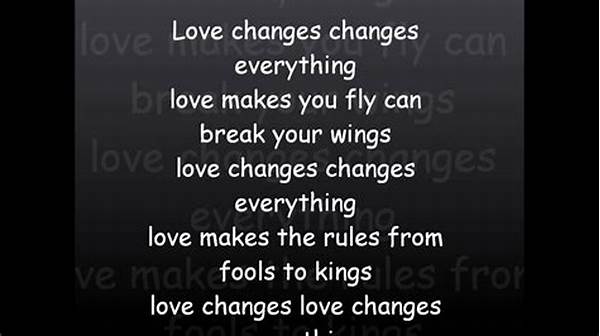Love songs have been the heartbeat of the music industry for decades. From the tender ballads of the past to today’s upbeat rhythms, the transformation is evident. The words used to express love have evolved, mirroring societal changes, technological advancements, and shifting cultural norms. Let’s dive into how the changes in love song lyrics over time reflect these transformations.
Read Now : Electrifying Bass Drops Compilation
Evolution of Romantic Expression
In the early 1900s, love lyrics were sweet, simple, and often poetic. Fast forward to the rock and roll era, and the lyrics took on an edgier feel, serving as a symbol of rebellion and freedom. The 1980s brought synths and power ballads, with lyrics dripping in passionate declarations. Enter the 21st century, where digital communication reigns supreme, and love lyrics have adopted a more casual, and sometimes explicit, tone. These changes in love song lyrics over time highlight how each generation redefines what it means to be in love. As platforms like social media shape modern communication, songwriters adapt their language to be more relatable, using contemporary slang and references. This evolution showcases how language and love are constantly intertwined, adapting to new societal influences.
Slang Writing Style in Love Lyrics
1. Casual Vibes: As time has passed, love songs have taken a laid-back approach with everyday language. The changes in love song lyrics over time show how artists favour intimacy, using words that sound like a conversation with a friend.
2. Emoji Influence: Emotions are now packed into tiny graphics. Changes in love song lyrics over time reflect the emoji culture, with songwriters capturing feelings in concise, impactful ways.
3. Text Speak: With texting as a primary communication form, lyrics often mimic text lingo. The changes in love song lyrics over time include abbreviations and shortcuts that mirror our fast-paced digital dialogue.
4. Pop Culture References: Modern love songs often drop pop culture names and events. Changes in love song lyrics over time show how these references help paint a vivid picture of love today.
5. Narrative Storytelling: Slang-filled storytelling gives love songs a relatable edge. The changes in love song lyrics over time demonstrate how the narrative style draws listeners into an emotional journey.
Rhythms of Modern Romance
Slang writing in songs isn’t just about words—it’s about vibes. The changes in love song lyrics over time portray how the infusion of slang makes these tracks feel authentic and of-the-moment. Language evolves, picking up the jargon that people use daily, making songs resonate on a deeper level. This transformation reflects how artists express love in a relatable fashion.
The phenomenon of changes in love song lyrics over time is about capturing the essence of contemporary emotions. Artists tap into the zeitgeist, using language that reflects the current mood and societal climate. Whether through playful banter, heartfelt confessions, or cheeky innuendos, the shifts in lyrical styles reveal a lot about how younger generations perceive love and relationships in the modern age.
How the Internet Changed Love Lyrics
With the internet’s arrival, love song lyrics underwent a seismic shift. Instant sharing of music brought diverse influences together, leading to eclectic combinations of genres and styles. Changes in love song lyrics over time show how global connectivity enhances creativity and expression. Today’s love songs often include various languages, catering to an international audience and reflecting a melting pot of cultural influences.
Read Now : Highest-selling Songs Globally
Moreover, social media’s instant feedback loop challenges artists to remain relevant. Changes in love song lyrics over time depict how immediate listener feedback pressures songwriters to innovate and adapt their style rapidly. This dynamic interaction between artists and audiences continues to reshape the landscape of love lyrics, ensuring they stay fresh and engaging.
Slang’s Impact on Emotions
Slang provides a powerful tool for artists to convey the rawness of emotions. Changes in love song lyrics over time reveal how using casual language in songwriting brings out authentic emotions. It’s all about relatability; when listeners hear words and phrases they use daily, the connection feels real. Slang captures the playful, intimate, and sometimes messy aspects of modern love.
Gone are the days when love songs strictly adhered to formal language. The changes in love song lyrics over time have paved the way for a more personal touch. By telling love stories in a language people live and breathe, these songs transcend mere entertainment, becoming a reflection of listeners’ own love experiences.
The New Era of Love Songs
As love continues to be a central theme in music, the changes in love song lyrics over time reflect an ever-evolving narrative. Today’s love songs are as varied as they are dynamic, offering something for everyone. With the boundary between different musical genres continually dissolving, artists blend slang, melody, and emotion in fresh ways.
The beauty of these changes in love song lyrics over time lies in their ability to adapt. They capture the spirit of the times, resonating with both current listeners and future generations who will look back on these tracks as cultural touchstones. The marriage of slang with heartfelt sentiment ensures that the story of love remains timeless, even as the words used to tell it continue to evolve.
Summary of Slang’s Evolution
To wrap up, the changes in love song lyrics over time offer a fascinating glimpse into the hybrid language of music today. Artists skillfully weave slang into their lyrics, capturing the essence of modern romance in bold and innovative ways. These verbal shifts reflect wider cultural dynamics and signal the enduring flexibility of love.
As we listen to current love songs and trace their lineage back through the decades, the evolution becomes more apparent. The changes in love song lyrics over time highlight not just shifts in language, but also shifts in how we, as a society, experience and express emotion. This lyrical journey, marked by the rise of slang and digital culture, ensures that love songs will continue to resonate across generations, cementing their place as a beloved art form.
